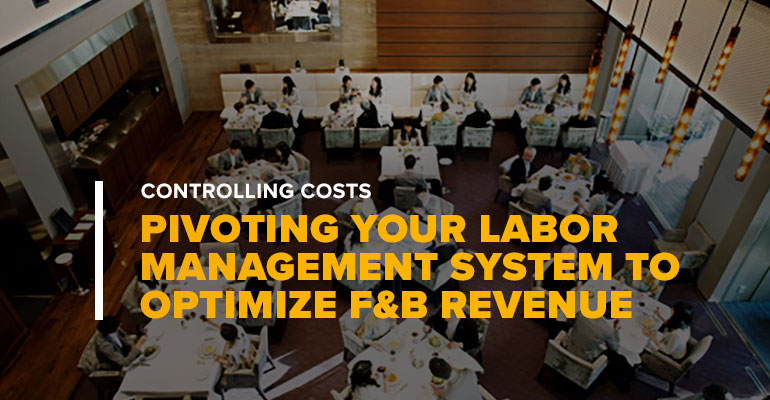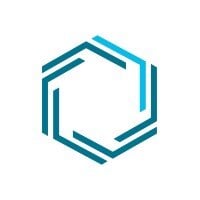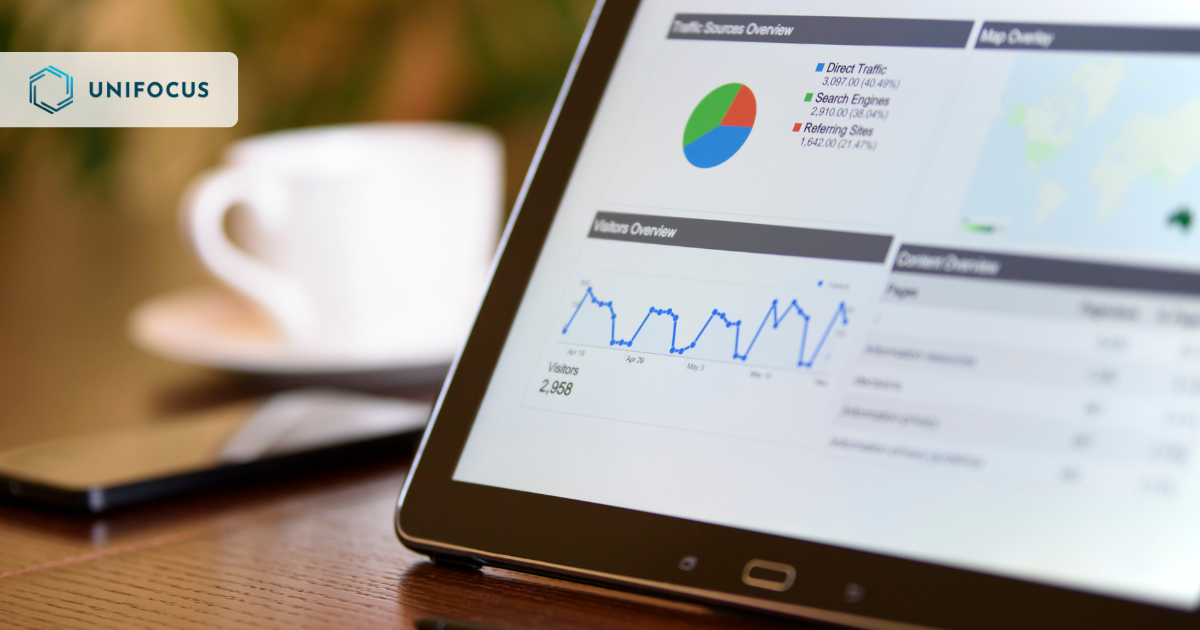August 26, 2018 - By Mark Heymann, Chairman & CEO, UniFocus - Published in Hotel Executive – Hotel owners and operators have long valued use of a labor management system as a smart and efficient way to understand, control and contain its largest cost. What fewer realize however, is that an effective LMS, properly deployed, can double as a revenue optimizer in their food and beverage outlets (as well as other revenue centers). Understanding the peaks and valleys of demand and using predictive scheduling can circumvent the likelihood of queues at the door that result in would-be guests turning away in frustration. This is particularly true in competitive urban markets, where guests have other dining options nearby and are less likely to be willing to wait for service.
Revenue-Building F&B Strategies
Historically, hotel operators have relied on several proven approaches to increase revenue in their food and beverage outlets:
- Increasing the length of the service demand period; for example, opening early for seniors to fill open tables at low demand times.
- Increasing prices.
- Implementing programs that focus on increasing average check or average revenue per purchasing customer.
Developing a cuisine offering that draws local as well as hotel-oriented business. - Providing the best customer service possible, creating demand by inspiring people to return and recommend the business to others.
To that last point, delivering high-quality service is driven by an establishment's ability to have the right staff in place at the time people want to be served. That's where an LMS with the capacity to identify and adjust staffing to high-demand periods provides a key advantage.
Optimize Your Share
Challenges arise when a restaurant is not adequately staffed for peak periods. If a potential customer calls to make reservations at 7:30 p.m. and the restaurant won't have a table available until 9:30 p.m., that customer will likely decline the table and spend his or her dollars elsewhere. At lunch, a customer might arrive without a reservation, see a line-potentially coupled with empty tables-and leave. Again, the dollars that customer planned to spend will still be spent but at a competitor's restaurant. Therefore, the questions every owner and operator should ask are: Is your operation consistently getting the largest possible share of your customers' dollars? Or is your delivery system structured so that you lose opportunities?
If no tables are available at the requested time, operations have little choice but to turn the business away. But what if those operations had a means of better maximizing seat utilization and could predict not just table demand but group size and seat demand? In essence, the same concept of seat yield that airlines use could apply to a restaurant during high-demand periods. How many times do two patrons tie up a four-top? If this could be predicted, the revenue equation might well change for the better.
An effective LMS accurately forecasts not just the total business over a period of time but pinpoints by incremental periods when demand is going to occur. Given accurate historical information, it can calculate when all seats are optimally utilized. For example, some restaurants adjust their waiting list based on group size, with larger parties tending to wait longer. With an effective structure in place, management might choose to seat two people at a four top when the LMS indicates it makes business sense to do so and at other times hold the table open for potential larger groups. This is a bit like a room yield system that recommends declining a request for a one-night Tuesday stay because it has forecast a more lucrative three-day stay starting on that same Tuesday-without the Tuesday room, the Wednesday and Thursday rooms would be lost. A good LMS ties work content to customer demand patterns.
Take the real-life example of a large restaurant group specializing in breakfast-a key meal for hotel restaurant business. Long lines on certain days of the week were resulting in customer losses. Upon review, management realized the ratio of bus staff to servers was constant throughout the day. Therefore, at peak times, tables sat dirty waiting to be cleaned before more customers could be seated.
If a customer is standing in line but sees empty tables, that indicates management didn't accurately forecast and staff properly. An inaccurate forecast can cause understaffing, which, as this restaurant group experienced, negatively impacts customer satisfaction levels and intent to return and recommend.
By implementing more accurate forecasting techniques that could better predict peak times, the operation was able to adjust the ratio of bussers to servers as needed. More bussers at the breakfast peak resulted in faster turn times and a shorter line, increasing revenue as more customers were served and retained.
An effective LMS makes it easy to reengineer service delivery to an establishment's advantage driven by accurate forecasting. It can tell management when a queue will occur and then change service parameters to help reduce wait time. For example, it can reduce the average lunch turn time from one hour to 50 minutes at peak while allowing a more leisurely lunch when business is lighter. Other approaches that impact turn times include having a runner at peak (which helps get food to tables faster), adding an extra body in the kitchen during a three-hour peak, or, as noted earlier, cleaning tables faster-all of which will help drive more covers.
Taking advantage of an LMS with the flexibility to not only forecast but adjust staffing parameters while still beating customer expectations at peak times can drive incrementally more revenue for a food and beverage operation. Here are just a few scenarios:
- A restaurant has a two-hour lunch peak, with customers typically staying for one hour. The operation can therefore expect somewhere between 1.75 and two table turns on average during that peak. If the restaurant has 70 tables and 225 seats, and an average utilization of 75 percent, there are 170 people seated when the restaurant is full. Flipping each table twice, the establishment can accommodate 340 customers per meal period. But by using an LMS that understands work content, the restaurant can reengineer the service delivery process-by adding another runner, perhaps, or a server-with the goal to reduce the typical one-hour stay to 50 minutes. And that, in turn, increases the potential number of customers per meal period to 408 people, improving the restaurant's revenue. What's more, by reducing the amount of time between seatings, the queue shrinks and more customers will remain to be served.
- At a high-volume hotel bar, customers-to-staff is generally a fixed parameter (sales per hour) maintained throughout the entire period, from 9 p.m. to 2 a.m. However, if an LMS enables management to adjust the standard to take into account a peak time of 10:30 p.m. to 1 a.m., the bar not only can serve more customers but those customers don't have to wait as long between drinks.
- A restaurant is losing customers due to the host's inability to accurately estimate wait times. Too often, customers bail when they're told to expect a 10-minute wait that turns into 20 or, conversely, are told to anticipate a 30-minute wait and consequently leave only to have a table open up in 15 minutes. A good LMS can help improve wait time estimates. It puts parameters and standards in place that, by improving customer retention, help recover and drive revenue.
On a related note, not only do restaurants generally find it challenging to accurately estimate wait times but they also tend not to have systems in place to record how many customers walk away. They might not track, for instance, how many beepers get dropped off by those who abandon the line, or how many customers fail to respond when their name is called. Doing a better job of tracking how much business is being lost can help an organization better understand its true demand structure. And that can spur a change in the entire delivery system, whether it's by adding a server on the floor at peak periods or shifting to a team-based service model. Additionally, tracking "lost business" can change the forecasting approach, which in many cases may only count actual customers served instead of actual customers served plus the customers who wanted to be served but left.
The Strategic Queue and Other Creative Approaches
All said, there can be strategic advantages to creating a certain length of queue, particularly if a restaurant includes a bar operation. A controlled 20-minute wait at dinner can encourage customers to spend that time at the bar, where they will likely order drinks and drive more revenue.
Also, look at under-utilized resources to create more revenue opportunities, particularly in environments in which people can make last-minute decisions concerning where they spend their dollars. We once consulted with a hotel that featured a winding staircase leading up from the lobby to the restaurant. At the bottom of the stairs was the lobby bar, with a number of tables and chairs that sat empty in the morning hours. At breakfast time, hotel guests would venture to the stairs, look up to see a long line leading into the restaurant, and opt to cross the street to a coffee shop instead. On our recommendation, management revamped its service, setting up the lobby bar for continental breakfast while the restaurant continued to serve a full breakfast upstairs. This opening of an additional "outlet" was also adjusted based on forecasted customers and peak time needs. As a result, instead of continuing to lose revenue, the hotel retained its breakfast customers by simply shifting demand from one area to another.
Today's technology makes identifying these kinds of opportunities far less complex. With an LMS that accurately forecasts by period of day, operators can easily improve table time, improve turn time, and ensure the right number of people are in place with the right skills at the right time to deliver the kind of service that not only keeps customers there but keeps them coming back.
Looking forward: LMS and Yield Management
While certain service-oriented businesses-like airlines and hotel rooms operations-have been using yield management systems for years, the same is not true for food and beverage or other service operations within a hotel, like retail. This is another area that an effective LMS and its key forecasting components can measurably impact. I'll address this topic in a future article.
HotelExecutive.com retains the copyright to the articles published in the Hotel Business Review. Articles cannot be republished without prior written consent by HotelExecutive.com.






